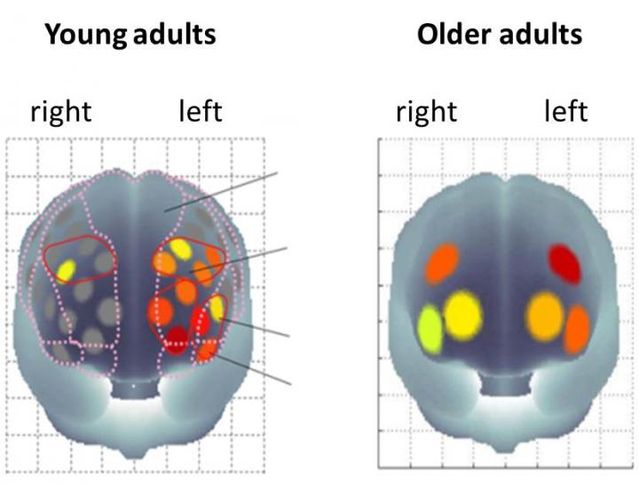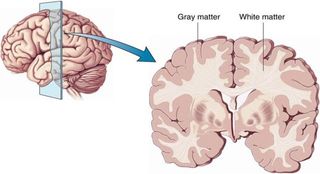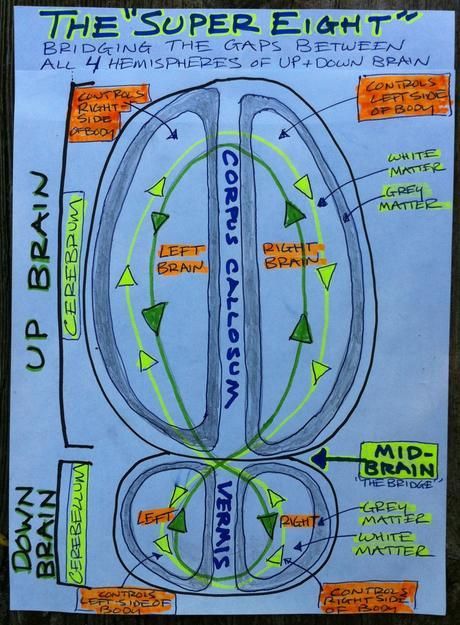
from Psychology Today:
https://www.psychologytoday.com/blog/the-athletes-way/201510/physical-activity-is-the-no-1-way-keep-your-brain-young



Sent from my iPhone
Stroop-interference-related cortical activation patterns are shown.
Source: University of Tsukuba, used with permission
Every day, my inbox seems to be flooded with new findings that physical exercise improves brain health and cognitive function. Yesterday, my mother, along with about a dozen other people, forwarded me a New York Times article from the Sunday Review, "Can You Get Smarter?(link is external)" by op-ed writer, Richard A. Friedman. My mom summed up the article in her email saying, "Did you see this? Exercise!! :-)"
I've been writing about the link between physical fitness and mental fitness for over a decade. Since the beginning, I've also stated my belief that maintaining close-knit human bonds is second only to exercise in terms of our lifelong physical and psychological well-being, which is something Friedman also speaks about in his article.
Many of the findings that I published 10 years ago in The Athlete's Way: Sweat and the Biology of Bliss(link is external) were mentioned by Friedman in his recent NYT article such as, the idea that mindset is never fixed because of neuroplasticity and that the neurogenesis of new neurons caused by a protein called brain-derived neurotrophic factor (BDNF) is triggered through aerobic exercise. As Friedman explains,
"Intriguingly, exercise in humans and animals increases the level of a protein called brain-derived neurotrophic factor(link is external), or BDNF, in the blood and brain. BDNF promotes the growth and formation of new neurons, and it may be responsible, in part, for a remarkable effect of exercise on the brain: an increase in size of the hippocampus that is linked with improved memory.Conversely, adverse experiences like major depression can lower BDNF levels and are associated with hippocampal shrinkage, a phenomenon that helps explain some of the cognitive impairments that are a hallmark of depression. Aside from making people feel better, antidepressants can block the depression-induced drop in BDNF, so these drugs are, in a sense, neuroprotective."
White Matter and Gray Matter Work Together to Optimize Brain Function
Something that I did not write about a decade ago—but which has come to light in recent years—is that exercise seems to optimize both gray matter brain volumes and white matter integrity.

Source: MS blogspot/Labeled for reuse.
Gray matter(link is external) houses the neurons in specific brain regions. White matter(link is external)facilitates the communication between various brain regions. Gray and white matter work together to optimize brain function. The fact that physical activity benefits both gray and white matter is the primary reason that exercise is the No. 1 way to keep your brain young.
Recently, researchers at the Beckman Institute(link is external) at the University of Illinois at Urbana-Champaign, led by Art Kramer(link is external) identified that older adults who regularly engage in moderate to vigorous physical activity tend to have better brain function and greater white matter integrity than their less-fit peers. They also have increased cognitive flexibility.
Cognitive flexibility is a person's ability to switch between modes of thought and to simultaneously think about multiple concepts. I wrote about these findings in an August 2015 Psychology Today blog post, "Why Does Physical Activity Improve Cognitive Flexibility?"
Previously, other studies by Kramer and his colleagues have found white matter improvement linked to physical activity in various age groups. In 2014, Chaddock-Heyman et al found that higher levels of aerobic fitness in children is associated with improved white matter integrity. The team identified that exercise improves the microstructures of white matter in the brain. White matter integrity is linked to faster neural conduction between brain regions and superior cognitive performance.
In two separate 2014 studies—released within the same month—the Beckman researchers reported that physical activity improved the white matter integrity of physically fit children aged 9 to 10 and also in "low-fit" participants aged 60 to 78. I wrote about these findings in a Psychology Today blog post, "Why Is Physical Activity So Good for Your Brain?"
Active Body, Younger Brain
A new study by researchers in Japan led by Dr. Hideaki Soya(link is external), a professor of exercise biochemistry, from the University of Tsukuba and his colleagues shows, for the first time, a direct relationship between brain activity, brain function, and physical fitness in a group of older men.
The October 2015 study, "The Association Between Aerobic Fitness and Cognitive Function in Older Men Mediated by Frontal Lateralization(link is external)," was published in the journalNeuroImage. The researchers found that fitter men performed better mentally than their less-fit peers. The researchers believe the improved cognitive function was the result of using parts of their brains in the same way as people of a younger age.
According to Soya et al, when someone is young, he or she primarily uses the left side of the prefrontal cortex for mental tasks involving short-term memory, understanding the meaning of words and the ability to recognize previously encountered events, objects, or people. However, as we get older, people tend to also use parts of their prefrontal cortex on the right side of the cerebrum(link is external) (Latin for "brain") during these tasks. Both hemispheres of the prefrontal cortex are believed to play a role in our executive function, memory,intelligence, language, and vision.
The researchers said that for tasks involving the temporary storage and manipulation of memory, long-term memories, and inhibitory control—younger adults typically favor the right side of the prefrontal cortex, while older adults engage both hemispheres.
In a press release the researchers said, "This phenomenon has been coined HAROLD (hemispheric asymmetry reduction in older adults) and reflects the reorganization of the brain as compensation for reduced brain capacity and efficiency due to age-related structural and physiological decline."

Example of the Stroop test.
Source: Wikimedia/Creative Commons
For this study, men aged 64-75 years underwent an exercise test to measure their aerobic fitness. The men, whose physical fitness levels varied greatly, then performed a Stroop test to measure their selective attention, executive function, and reaction time. The Stroop test involves reading the word for a color, such as "blue, green, red," but asking the subject to name the color of the word rather than read the word itself.
When the color of the letters doesn't match the word, it takes the brain longer to react, as you can see by taking the Stroop test above. The length of someone's reaction time is used as a measurement of brain function. During this experiment, the brain activity in the prefrontal cortex was measured throughout the Stroop test using a unique neuroimaging technique called Functional Near Infrared Spectroscopy (fNIRS).
This brain imaging technique measures blood oxygen concentration in surface blood vessels using a set of wearable probes in a cap that is placed on the head. Active brain cells require fresh oxygenated blood which dislodges the deoxygenated blood from that region. fNIRS technically measures the changes in color between oxygenated blood (red) and deoxygenated blood (blue). This provides a measurement of brain activity.
The results showed that during the Stroop test older adults typically used both sides of the prefrontal cortex actively, with no difference between right and left, verifying the HAROLD phenomenon amongst this group of men. However, when the association between aerobic fitness and Stroop reaction time was analyzed, the men who were aerobically fit had shorter reaction times.
The researchers were able to identify that higher aerobic fitness is associated with higher left prefrontal cortex activity. Based on these findings, the researchers conclude that more aerobically fit older men can perform better mentally than less-fit older men because they're able to use specific brain regions more fluidly when necessary.
In fact, the fitter older men were using parts of their brains in the same way as they would have when they were younger, the researchers found. These results suggest that higher aerobic fitness is associated with cognitive function via lateralized frontal activation in older adults.
In a press release, Professor Soya concluded, "One possible explanation suggested by the research is that the volume and integrity of the white matter in the part of brain that links the two sides declines with age. There is some evidence to support the theory that fitter adults are able to better maintain this white matter than less fit adults, but further study is needed to confirm this theory."
Conclusion: Physical Activity, Brain Connectivity, and Superfluidity
Based on decades of research, I've developed an original hypothesis that physical activity optimizes the structure, function, and connectivity of both hemispheres of the cerebrum and both hemispheres of the cerebellum(link is external) (Latin for "little brain").
To date, most research has focused primarily on the lateralization and connectivity between the left and right hemispheres of the cerebrum across the corpus callosum. But in recent months, there has been a groundswell of research that examines the role of the cerebellum in cognitive function and the creative process.
Below is a rudimentary sketch that I drew a few years ago to illustrate my concept of superfluidity and brain connectivity between all four hemispheres:

Optimizing the structure, function, and connectivity of all four brain hemispheres is the key to superfluidity.
Source: Illustration and photo by Christopher Bergland
I have a hunch that creating a state of superfluidity, which is the highest tier of flow, occurs when there is "zero friction, entropy, or viscosity" between all four brain hemispheres. I believe that the optimization of gray and white matter in the cerebrum and the cerebellum is the key to cognitive flexibility, creativity, and peak performance. This is still an educated guess. That said, I am constantly searching for new clues to prove my hypothesis. Stay tuned!
If you'd like to read more on this topic, check out my Psychology Today blog posts,
- "Superfluidity: Decoding the Enigma of Cognitive Flexibility"
- "Einstein's Genius Linked to Well-Connected Brain Hemispheres"
- "Why Does Overthinking Sabotage the Creative Process?"
- "Do Brain Training Games Actually Improve Cognitive Function?"
- "One Thousand Reasons Exercise Is the Best Medicine"
- "Why Do Aerobically Fit Children Have Better Math Skills?"
- "One Simple Way to Improve Your Brain Function"
- "The Neuroscience of Madonna's Enduring Success"
- "Scientists Discover Why Exericise Makes You Smarter"
- "The "Exercise Hormone" Irisin is NOT a Myth"
- "Can Physical Activities Improve Fluid Intelligence?"
- "Too Much Crystallized Thinking Lowers Fluid Intelligence"
- "The Neuroscience of Imagination"
- "The Cerebellum May Be the Seat of Creativity"
© 2015 Christopher Bergland. All rights reserved.
Sent from my iPhone
No comments:
Post a Comment